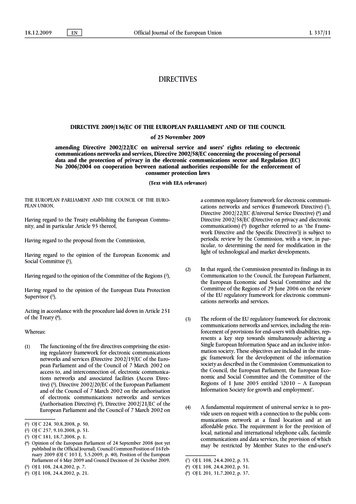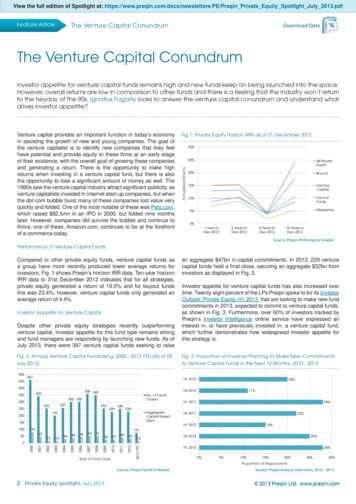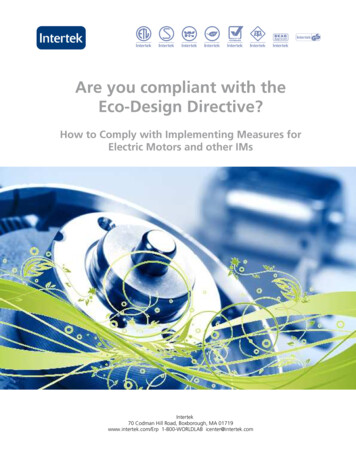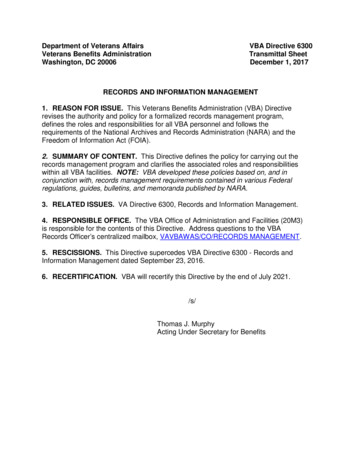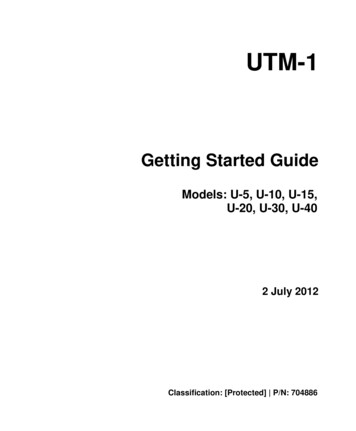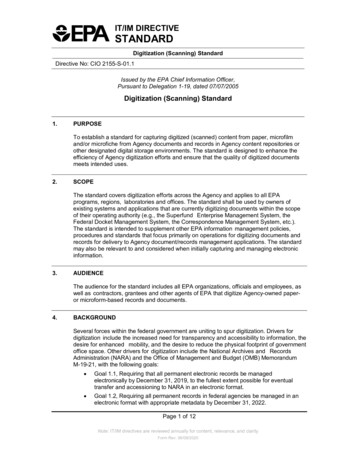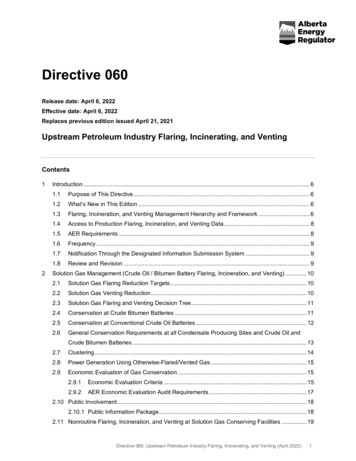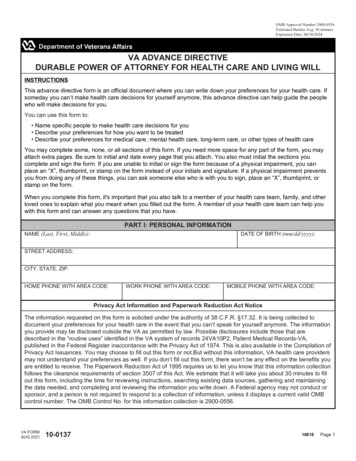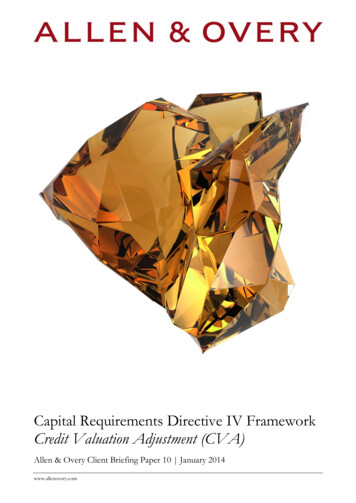
Transcription
Capital Requirements Directive IV FrameworkCredit Valuation Adjustment (CVA)Allen & Overy Client Briefing Paper 10 January 2014www.allenovery.com
2CRD IV Framework: Credit Valuation Adjustment (CVA) January 2014CRD IV Framework:Credit Valuation Adjustment (CVA)This briefing paper is part of a series of briefings onthe implementation of Basel III in Europe via theCapital Requirements Directive IV1 (CRD IV) andthe Capital Requirements Regulation2 (CRR),replacing the Banking Consolidation Directive3 andthe Capital Adequacy Directive.4 The legislation ishighly complex: these briefings are intended toprovide a high-level overview of the architecture ofthe regulatory capital and liquidity framework andto draw attention to the legal issues likely to berelevant to the in-house lawyer. This briefing is forgeneral guidance only and does not constitutedefinitive advice.2013/36/EU.Regulation 575/2013.3 2006/48/EU.4 2006/49/EU.This briefing paper is based on informationavailable as at 17 January 2014.12NOTE: In relation to the topics discussed inthis briefing, the CRR contains a number ofdiscretions for member states in relation tonational implementation. The regime maytherefore differ across member states in anumber of respects.Background and ScopeSourcesThe global financial crisis has prompted legislators andregulators to introduce reforms and strengthen existinglegislation to address perceived weaknesses inderivatives markets. These reforms include a numberof measures aimed at reducing counterparty credit riskincluding more robust back-testing and stress testing,the requirement for certain derivatives contracts to becleared through a central counterparty (CCP),increased capital requirements and, to the extentderivatives contracts are not cleared, increasedcollateral and even higher capital requirements (thusincentivising central counterparty clearing). Thisbriefing paper will focus on capital requirements and,in particular, the new requirements in respect of CVArisk.CRR (Regulation 575/2013): Recital (83); Part Three:Article 92(3)(d), Article 162(2)(h), Article 273(6), TitleVI (Articles 381-386), Part Nine: Article 456(2),Article 457(h) and, Part Ten: Article 482. Allen & Overy LLP 2014UK Financial Conduct Authority (FCA) PolicyStatement (PS13/10) CRD IV for Investment Firms(December 2013) (the FCA Policy Statement).UK Prudential Regulation Authority (PRA) PolicyStatement (PS7/13) Strengthening capital standards:implementing CRD IV, feedback and final rules(December 2013) (the PRA Policy Statement).PRA Supervisory Statement (SS12/13) Counterpartycredit risk (December 2013) (the PRA SupervisoryStatement).
3CRD IV Framework: Credit Valuation Adjustment (CVA) January 2014IntroductionPreviously, the Basel II regulatory capital regimeaddressed the risk of counterparty default in respectof derivatives transactions but did not address CVArisk and, thus, failed in some cases to capture therisk of mark-to-market losses resulting from adeterioration in the creditworthiness ofcounterparties to derivatives transactions. This ledto a number of institutions not holding adequatecapital to cover CVA losses during the financialcrisis, and indeed, mark-to-market losses being a“greater source of losses than those arising fromoutright defaults”.5Consequently, as part of the drive to make sure allunderlying, material risks are addressed in thecapital regime, Basel III sought to strengthen theglobal counterparty credit risk framework by,amongst other things, increasing the risk weights ofcounterparty credit exposures relating to derivativestransactions entered into with financial institutions(although these will be lower in respect of clearedtransactions) and introducing requirements forinstitutions to set aside regulatory capital to coverCVA risk (in addition to counterparty default risk).The measures target financial institutionsspecifically as they are perceived as being the mostsensitive to systemic risk due to the sheer volume ofderivatives exposures concentrated within arelatively small number of counterparties whichcould, as it did in 2008, lead to a simultaneousSee BCBS: Basel III: A global regulatory framework for more resilient banksand banking systems dated June 2011 at Section A, paragraph 2(14)(b).5deterioration of credit quality at times of marketstress and pro-cyclicality.In Europe, CVA risk is addressed in the CRRalthough it differs in some significant respects tothe Basel III proposals. The European CVA regimetook effect from 1 January 2014 and applies tocredit institutions and investment firms enteringinto uncleared OTC derivatives transactions andsecurities financing transactions which are notsubject to an exemption.It is worth noting that, in respect of unclearedderivatives transactions, the European MarketInfrastructure Regulation (EMIR)6 also requiresfinancial counterparties to hold an “appropriate andproportionate amount of capital to manage the risknot covered by appropriate exchange of collateral”7:it is expected that this requirement will be satisfiedby compliance with the CRR.8 It is, however,unclear how financial counterparties (as defined inEMIR) will be expected to comply with their EMIRcapital obligations to the extent they are not subjectto the CRR (ie they are not institutions).Regulation (EU) No 648/2012 of the European Parliament and of theCouncil on OTC derivatives, central counterparties and traderepositories dated 4 July 2012.7 See Article 11(4) EMIR.8 See Joint ESMA/EIOPA/EBA Discussion Paper on TechnicalStandards on Risk Mitigation Techiques for Uncleared OTCDerivatives dated 6 March 2012.6What is CVA risk?CVA risk is the risk of loss caused by changes in thecredit spread of a counterparty due to changes in itscredit quality. CVA is “an adjustment to the midmarket valuation of the portfolio of transactionswith a counterparty” which “reflects the currentmarket value of the credit risk of the counterpartyto the institution”.9 It has also been described as“the difference between the ‘hypothetical’ value ofthe derivative transaction assuming a risk-freecounterparty and the true value of the derivativetransaction that takes into account the possibility ofchanges in creditworthiness of the counterparty9 Allen & Overy LLP 2014See Article 381 (Meaning of Credit Valuation Adjustment) CRR.
4CRD IV: Credit valuation adjustment (CVA) January 2014(including the possibility of the counterparty’sdefault)”.10 The purpose of CVA is to quantify therisk that counterparties to derivatives transactionsmay be more or less creditworthy at any given timeduring the life of a transaction because this willaffect the value of the transaction to thecounterparties. It is, therefore, an importantcomponent in valuing derivatives. It is imperativethat this value is as accurate as possible, particularlySee EC consultation on counterparty credit risk – frequently askedquestions (MEMO/11/77) dated 9 February 2011.10during times of market stress when markets aremore volatile, so that counterparties can ensure thattransactions are correctly valued for accountingpurposes and appropriate regulatory capital is setaside to protect against the risk of insolvency arisingfrom such losses.The calculation of CVA takes into account certaincounterparty credit risk mitigants such as nettingand collateral arrangements and certain offsettinghedges and seeks to cover any risk that is left afterthese other mitigants have been factored in.ScopeUnder the CRR, credit institutions and investmentfirms are required to hold additional own funds dueto CVA risk arising from OTC derivatives (otherthan credit derivatives used for credit risk mitigation(CRM)11 purposes) and, if CVA risk exposures arematerial, securities financing transactions.12However, exemptions are available in respect of:(i) transactions cleared through a CCP (includingtransactions with a qualifying CCP andtransactions between a client and a clearingmember when the clearing member acts as anintermediary between the client and therelevant CCP);13Article 92(3)(d) CRR. “OTC derivatives” are not specifically definedin the CRR but derivative instruments relevant for counterparty creditrisk purposes are listed in Annex II of the CRR. Annex II sets out a listof derivative types which includes derivatives within points (4) to (7)and (9) and (10) of Section C of Annex I of MiFID (2004/39/EC).“OTC” means derivatives executed on a regulated market or thirdcountry equivalent (this is how EMIR defines “OTC”). It is worthnoting that the CRR definition of derivatives differs from EMIR in thatit does not include point (8) of Section C of Annex 1 of MiFID.12 Article 382(2) CRR. “Securities financing transactions” are notdefined in the CRR but are understood as meaning references tosecurities or commodities lending or borrowing transactions andrepurchase transactions. See PRA Consultation Paper (CP5/13)“Strengthening capital standards: implementing CRD IV” dated August2013 at paragraph 8.11. See also the PRA Policy Statement at paragraph8.5 and the PRA Supervisory Statement at paragraph 3 in respect of thePRA’s determination of when risk exposures arising from securitiesfinancing transactions should be deemed material and be included inthe scope of the own funds requirements for CVA in accordance withArticle 382(2) CRR.13 Article 382(3) CRR.11 Allen & Overy LLP 2014(ii) transactions with non-financial counterparties14which do not exceed the ‘clearing threshold’ asdefined in EMIR15 (known as NFC-s)regardless of whether such counterparties areestablished in the EU or in a third country - thiseffectively includes all undertakings other thanfinancial counterparties16 and CCPs;17 18(iii) intra-group transactions (subject to nationallaws requiring the structural separation of abanking group);19(iv) transactions with pension schemearrangements20 (until the transitional provisionsin EMIR cease to apply);21(v) transactions with entities out-of-scope of EMIR(including members of the ESCB and othermember states’ bodies performing similarfunctions and other EU public bodies chargedwith or intervening in the management of thepublic debt, the Bank for InternationalSettlements, multilateral development banks,certain public sector entities, the EuropeanFinancial Stability Facility and the EuropeanAs defined in Article 2(9) EMIR.As defined in Article 10 EMIR.16 As defined in Article 2(8) EMIR.17 As defined in Article 2(1) EMIR.18 Article 382(4)(a) CRR.19 Article 382(4)(b) CRR.20 As defined in Article 2(10) EMIR.21 Article 382(4)(c) and Article 482 CRR.1415
5Stability Mechanism) (Out-of-ScopeEntities);22 23 and(vi) transactions with regional governments or localauthorities which are assigned a 0% risk weightin accordance with Article 115 of the CRR.24CVA capital charges will, therefore, only apply toOTC derivatives and certain securities financingtransactions entered into by credit institutions andinvestment firms with:(i) other financial counterparties (FCs) which donot benefit from an exemption (including otherauthorised credit institutions, authorisedinvestment firms, alternative investment funds(AIFs) managed by authorised or registeredalternative investment fund managers (AIFMs),authorised insurance, assurance and reinsuranceundertakings and authorised UCITS) and thirdcountry equivalents of them; and(ii) non-financial counterparties above the ‘clearingthreshold’ (NFC s) and third countryequivalents of them,provided that such transactions are not clearedthrough a CCP (either directly or via a clearingmember as intermediary for a client) and are notintra-group. As cleared transactions are exempt, theintroduction of the CVA charge can be seen as anincentive to encourage central counterparty clearing.Further analysis may be needed to ascertain whethercertain legal persons fall within the exemptions (forexample, individuals contracting in a personalcapacity, certain international organisations andnon-EU central banks) and also in respect of whichentities constitute equivalent third country entitiesfor the purposes of the NFC categorisation.The carve-out for NFC-s, pension schemearrangements and Out-of-Scope Entities from thescope of the change is not consistent with theBasel III requirements, which do not provideexemptions for such entities. This potentially placesEuropean institutions at a considerable advantage inrespect of pricing trades with these counterpartiesas compared to third country institutions who havefollowed the Basel III approach and who will,consequently, be required to apply a CVA charge tosuch trades. The rationale for the Europeanexemption is that the CVA charge is likely to bemuch more significant in respect of transactionswith counterparties (such as certain corporates) whotrade on an uncollateralised basis and/or in respectof whom there is no suitable offsetting CDS hedgeand whose trades will also be exempt from clearingand increased collateral requirements. As suchentities have been specifically exempted fromclearing and increased collateral requirements, itseems punitive to subsequently apply increasedcapital requirements to those transactions (the costof which will likely be passed on the relevantcounterparties). It is possible that the Europeanposition may change in line with the Basel IIIframework to create a more level playing fieldglobally if European national authorities choose toapply additional capital charges in respect of thesecounterparties in response to pressure from theinternational community.As defined in Articles 1(4) and 1(5) EMIR.Article 382(4)(d) CRR.24 Article 382(4)(d) CRR.2223www.allenovery.com
6CRD IV Framework: Credit Valuation Adjustment (CVA) January 2014How CVA is calculatedCalculating CVA risk is complex. Historically,institutions did not calculate CVA but it becamemore common in the early 2000s with some largeinstitutions setting up dedicated CVA desks tohedge CVA risk often across the firm as a whole(but sometimes on a desk-by-desk basis). Followingthe financial crisis there has been a renewed focuson managing counterparty credit risk and managingCVA risk has become more common and moresophisticated. The sophistication of a firm’s existingsystem for calculating and hedging CVA will varydepending on a number of factors, for example, thesize of the firm and whether it has been costeffective to build the relevant systems in the contextof the business.One of the reasons for the complexity in calculatingCVA is that CVA must be calculated on a portfoliobasis for a particular netting counterparty takinginto account netting and collateral arrangements forthat counterparty (which are also calculated on aportfolio basis) and any offsetting hedges before theeffect of CVA can be calculated in respect of aparticular trade. To calculate an incremental CVA inrespect of any new trades, the CVA desk (if there isone) will look at whether entering into the newtrade will have a positive or negative effect on theCVA for that counterparty as a whole. This costmay be recognised in the pricing of the trade. Theadvent of the new CVA capital charge may increasethe cost of entering into new trades within its scope,as the cost of holding extra capital is taken intoaccount by a firm. Institutions will be likely to lookto improve their systems and hedge their CVA riskin order to minimise capital charges.account eligible hedges (using the exposureamount and the relevant credit spread). It doesnot take into account other market factors thatmay be relevant such as interest rate or currencyrisk. The CRR provides that if a credit spread isnot available for a counterparty, a proxy spreadshould be used. There have been concernsabout how institutions may need to revise theirinternal models to comply with the rules onproxy spreads in the CRR.(ii) Standardised method26 – To the extent a firmdoes not use advanced method for thecalculation of own funds requirement for CVArisk (including if an appropriate proxy spreadwith reference to rating, industry and region ofthe counterparty is not available),27 it shouldcalculate it in accordance with the standardisedmethod taking into account eligible hedges. Inpractice, this is likely to be a more capitalintensive option for institutions.There is also an alternative method of calculatingthe own funds requirement for those institutionswith a small trading book using the OriginalExposure Method28 for CRR valuation if the priorconsent of the relevant competent authority isobtained.The CRR specifies two main methods for thecalculation of CVA (the formulae for which are setout in the text of CRR):(i) Advanced method25 – This involves using afirm’s internal models (to the extent a firm ispermitted to do this under the CRR) tocalculate the impact of changes in counterpartycredit spreads on the relevant CVA taking into25Article 383 CRR. Allen & Overy LLP 2014Article 384 CRR.Article 383(6) CRR.28 Article 385 CRR. See also paragraph 8.7 (CVA risk calculation) in thePRA Policy Statement in respect of guidance on the PRA’s expectationsrelated to permission to use the approach defined in Article 385 tocalculate the own funds requirements for CVA risk.2627
7Eligible hedgesInstitutions which do not hedge CVA are likely tobe more vulnerable to losses in times of marketstress. The CRR regime incentivises institutions tohedge CVA risk, if possible, by providing thatentering into “eligible hedges” will reduce theamount a firm must hold against CVA risk. Eligiblehedges themselves will not be subject to a CVAcharge.By comparison, the Basel III frameworkadditionally allows institutions to enter into “singlename contingent CDS and other equivalent hedginginstruments referencing the counterparty directly”32so that institutions can tailor the CDS protection toa specific transaction. It is unclear whether a singlename CCDS can be viewed as a single-name CDSfor eligible hedge purposes.Under CRR, “eligible hedges”29 must be:Market participants have raised concerns about theCVA charge being linked too closely with illiquidCDS markets which can be volatile and,consequently, could introduce more counterpartycredit risk rather than help eliminate it. For manycounterparties, CDS spreads are not available or areilliquid which is one of the reasons why marketparticipants have been concerned that proxyspreads should be used correctly. It is worth noting,however, that the single-name CDS requirementonly permits the counterparty itself to be referenced(and not a proxy) which would mean that onlyindex CDS would be permitted as eligible hedges inrespect of names for which no credit spread wasavailable (and these may or may not be wellcorrelated to the underlying exposure). It may alsobe that the ability to use eligible hedges forregulatory capital purposes increases the market forcertain, particularly index, CDS and therefore haswider ramifications for the CDS market as a whole.There have been concerns that, in respect of certainless liquid names, purchasing CDS as a hedge forCVA risk may lead to pro-cyclicality if creditspreads widen as a result of institutions enteringinto more CDS contracts.(i) used for the purpose of mitigating CVA riskand be managed as such; and(ii) either:(a) single-name credit default swaps (CDS) orother equivalent hedging instrumentsreferencing the counterparty directly; or(b) index CDS, provided that the basisbetween any individual counterparty spread(or proxy therefor) and the spreads ofindex CDS hedges is reflected, to thesatisfaction of the competent authority, inthe value-at-risk and the stressed value-atrisk.Over-hedging of exposures with a single name CDSunder the advanced method is not permitted.30Other types of hedge are not permitted and, inparticular, tranched or nth-to-default CDS andcredit-linked notes.31Notably, the CRR does not permit hedges relatingto other factors that may affect CVA (for example,interest rate risk) to be taken into account as eligiblehedges (the position may be different in the otherjurisdictions where market hedges may bepermitted).Article 386(1) CRR.Article 386(1) CRR.31 Article 386(2) CRR.2930See BCBS: Basel III: A global regulatory framework for more resilient banksand banking systems dated June 2011 at paragraph 103.32www.allenovery.com
8CRD IV Framework: Credit Valuation Adjustment (CVA) January 2014ImpactThe impact in respect of the new CVA charge is stillunclear.Once FCs and NFC s are required to comply withclearing and collateral requirements under EMIR,the impact of the CVA charge may be more limitedas standardised transactions between these entitieswill be cleared and non-standardised transactionswill attract a lower capital charge once collateral andeligible hedges are taken into account (although, asdiscussed above, it is currently unclear how nonfirm FCs will be expected to comply with theirEMIR capital requirements). However, on currentexpectations with regard to the implementation ofEMIR, clearing will not take effect until mid-2014 atthe earliest and increased collateral requirementsmay not take effect until the end of 2015 whereasthe CVA charge applies from 1 January 2014,leaving institutions potentially facing higher capitalrequirements in the interim period.Additionally, if it remains the case that Europeannational authorities do not add additional ownfunds requirements for transactions with CRRexempt counterparties (for example, NFC-s), theimpact of the CVA charge may remain more limitedin the long term.This could put European institutions at acompetitive advantage over third countryinstitutions which have implemented Basel IIIwithout amendment and, therefore, cannot rely onsuch exemptions, thus leading to a less competitivepricing of trades. Although it is worth noting thatthere are fears that this (and other divergences fromthe Basel III framework, for example the inclusion Allen & Overy LLP 2014of market risk hedges in the calculation of CVA incertain jurisdictions) may undermine the credibilityof Basel III and global consistency and could leadto regulatory arbitrage.However, if European national authorities move torealign capital requirements with Basel III byintroducing additional national measures (and thuseffectively removing the exemptions for certaincounterparties included in the CRR), the new CVAcharge may have a much greater impact as it willforce institutions to hold increased capital in respectof uncleared and/or uncollateralised transactions the cost of which will likely be passed on to thecounterparty when the trade is priced (either by wayof CVA charge and/or via the cost of entering intoan eligible hedge). It may also put Europeaninstitutions at a competitive disadvantage in respectof hedging other risks, such as interest rate risk,associated with these trades which may impact theCVA but cannot be classified as eligible hedgesunder the CRR (whereas certain overseasinstitutions, for example, may be able to hedgemarket risk under their implementation of the Baselrules).There are also concerns about the mismatchbetween the accounting and regulatory capitaltreatment of CVA which could, for example, lead toeligible hedges being taken into account forregulatory capital but not accounting purposes andvice versa. Indeed, this has already led toconsiderable discussion in the market.The full impact of the new CVA charge, therefore,still remains to be seen.
9Transitional provisionsThe transitional provisions in EMIR which apply totransactions with pension scheme arrangements33also apply in respect of the CRR (ie transactions33with pension scheme arrangements are exempt untilthe transitional provisions cease to apply).3434Article 89(1) EMIR.Article 382(4)(c) and Article 482 CRR.EBA technical standards and reportsThe CRR mandates that various technical standards and reports shall be produced. In connection with CVA risk,the following standards and report have been/shall be produced:CRR E FORSUBMISSION TO THEEUROPEAN COMMISSIONEBA PUBLICATIONSArticle 382(5) (Scope)Draft regulatory technicalstandards to specify theprocedures for excludingtransactions with non-financialcounterparties established ina third country from the ownfunds requirement for CVArisk.Within 6 months of therelated EBA review (to beconducted by1 January 2015).None to date.Article 383(7)(Advanced Method)Draft regulatory technicalstandards to specify in greaterdetail:(a) how a proxy spread is tobe determined by the firm’sapproved internal model forthe specific risk of debtinstruments for the purposesof identifying ‘si’ and‘LGDMKT’ referred to inArticle 383(1); and(b) the number and size ofportfolios that fulfil thecriterion of a limited number ofsmaller portfolios referred to inArticle 383(4).1 January 2014.EBA final draft regulatorytechnical standards oncredit valuation adjustmentrisk for the determination ofa proxy spread and thespecification of a limitednumber of smaller portfoliosunder Article 383(7)(December 2013)(EBA/RTS/2013/17).Opinion of the EBA onCredit Valuation Adjustmentrisk for the determination ofa proxy spread (December2013) (EBA-Op-2013-03).Consultation on draftregulatory technicalstandards for the creditvaluation adjustment risk onthe determination of a proxyspread and the specificationof a limited number ofsmaller portfolios (July2012) (EBA/CP/2012/09).Consultation on creditvaluation adjustment risk forthe determination of a proxywww.allenovery.com
10CRD IV Framework: Credit Valuation Adjustment (CVA) January 2014CRR E FORSUBMISSION TO THEEUROPEAN COMMISSIONEBA PUBLICATIONSspread and the specificationof a, limited number ofsmaller portfolios (July2013) (EBA/CP/2013/24).Article 456(2)(Delegated Acts)EBA shall monitor the ownfund requirements for creditvaluation adjustment risk andsubmit a report to theEuropean Commission. Inparticular, the report shallassess:(a) the treatment of CVA riskas a stand-alone chargeversus an integratedcomponent of the market riskframework;(b) the scope of the CVA riskcharge including theexemption in Article 482;(c) eligible hedges; and(d) calculation of capitalrequirements of CVA risk.1 January 2015.None to date.National discretions andUK implementationThe CRR provides competent authorities with certain discretions:CRR SOURCENATURE OF DISCRETIONFCA/PRA APPROACHArticle 162(2)(h)(Maturity)An institution that uses an internal model tocalculate a one-sided credit valuationadjustment (CVA) may use, subject to thepermission of the competent authorities, theeffective credit duration estimated by theinternal model as “M”.In respect of FCA authorised firms, theFCA indicated it intends to exercise thisdiscretion (see Annex 3 (List of nationaldiscretions and FCA’s approach to theirapplication) to CP 13/6 CRD IV forInvestment Firms (July 2013)). ThePrudential sourcebook for InvestmentFirms (IFPRU) 4.14.4 G sets out guidanceon the use of internal CVA model forcalculation of the maturity factor “M”.In respect of PRA authorised firms, seeparagraph 2 (Factors which the PRAexpects firms to take into account whenapplying to certain permissions related tothe counterparty credit risk regulatoryframework) in the PRA SupervisoryStatement.Article 382(2) (Scope)An institution shall include securities financingtransactions in the calculation of own fundsrequired by Article 382(1) if the competentIn respect of FCA authorised firms, theFCA has indicated it intends to exercisethis discretion (see Annex 3 (List of Allen & Overy LLP 2014
11CRR SOURCEArticle 382(4)(b)(Scope)NATURE OF DISCRETIONFCA/PRA APPROACHauthority determines that the institution’s CVArisk exposures arising from those transactionsare material.national discretions and FCA’s approach totheir application) to CP 13/6 CRD IV forInvestment Firms (July 2013)).In respect of PRA authorised firms, see thePRA Policy Statement at paragraph 8.5and the PRA Supervisory Statement atparagraph 3 (Inclusion of securitiesfinancing transactions in the scope of theCVA capital charge) in respect of thePRA’s determination of when riskexposures arising from securities financingtransactions should be deemed materialand be included in the scope of the ownfunds requirements for CVA in accordancewith Article 382(2) CRR.Intra-group transactions will be excluded fromthe own funds requirements for CVA risk.However, member states may adopt nationallaws requiring the structural separation within abanking group, in which case competentauthorities may require intragroup transactionsbetween the structurally separated institutionsto be included in the own funds requirements.Further readingClient Briefing 1 (Introduction to Regulatory Capital and Liquidity)Client Briefing 5 (Collateral: Funded Credit Risk Mitigation in the Banking Book)Client Briefing 6 (Unfunded Credit Risk Mitigation in the Banking Book: Guarantees and Credit Derivatives)Client Briefing 8 (Counterparty Credit Risk)Client Briefing 9 (Clearing)ContactsKate SumpterPartnerTel 44 20 3088 2054kate.sumpter@allenovery.comEtay KatzDamian CarolanEmma LancelottPartnerTel 44 20 3088 3823etay.katz@allenovery.comPartnerTel 44 20 3088 2495damian.carolan@allenovery.comSenior PSLTel 44 20 3088 m
FOR MORE INFORMATION, PLEASE CONTACT:LondonAllen & Overy LLPOne Bishops SquareLondonE1 6ADUnited KingdomTel 44 20 3088 0000Fax 44 20 3088 0088GLOBAL PRESENCEAllen & Overy is an international legal practice with approximately 5,200 people, including some 530 partners, working in 44 offi cesworldwide. Allen & Overy LLP or an affiliated undertaking has an office in each of:Abu tBratislavaBrusselsBucharest (associated furtHamburgHanoiHo Chi Minh CityHong KongIstanbulJakarta (associated owMunichNew YorkParisPerthPragueRiyadh (associated office)RomeSão gton, D.C.YangonAl
credit quality. CVA is "an adjustment to the mid-market valuation of the portfolio of transactions with a counterparty" which "reflects the current market value of the credit risk of the counterparty to the institution".9 It has also been described as "the difference between the 'hypothetical' value of the derivative transaction .
